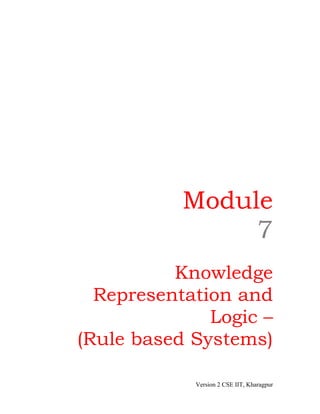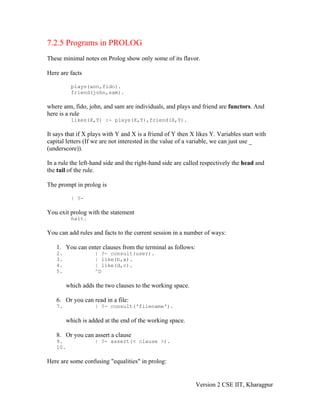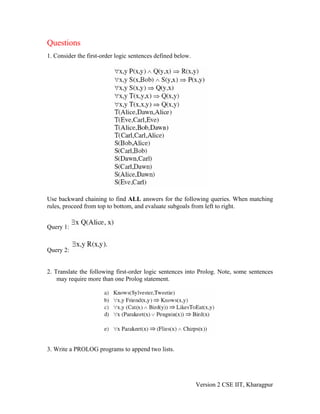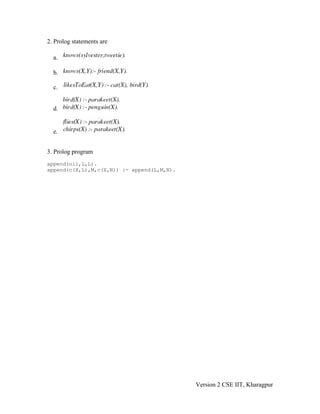The document discusses rule-based expert systems in Prolog, including examples of representing facts and rules, using variables, lists, and solving problems like factorials, membership, selection, and cryptography. It also provides an overview of expert systems, knowledge representation using rules, and the iterative development process of building and refining an expert system based on feedback from experts.




![then
?- factorial(5,F).
F = 120
?- factorial(X,120).
X = 5;
integer overflow
Here is why factorial(X,120) returns 5. For brevity, instead of
"factorial"
we will write "f".
f(X,120)
/ |
/ |
[0/N5,1/F5,1/N4,1/F4,2/N3,2/F3,3/N2,6/F2,4/N1,24/F1,5/N1]
/ +-----------------------+
/ | | |
f(0,1) f(N1,F1) X is N1+1 6 is X*F1
/ |
/ | [0/N5,1/F5,1/N4,1/F4,2/N3,2/F3,3/N2,6/F2,4/N1,24/F1]
/ +-----------------------+
/ | | |
f(0,1) f(N2,F2) N1 is N2+1 F1 is N1*F2
/ |
/ | [0/N5,1/F5,1/N4,1/F4,2/N3,2/F3,3/N2,6/F2]
/ +-----------------------+
/ | | |
f(0,1) f(N3,F3) N2 is N3+1 F2 is N2*F3
/ |
/ | [0/N5,1/F5,1/N4,1/F4,2/N3,2/F3]
/ +-----------------------+
/ | | |
f(0,1) f(N4,F4) N3 is N4+1 F3 is N3*F4
/ |
/ | [0/N5,1/F5,1/N4,1/F4]
/ +-----------------------+
/ | | |
f(0,1) f(N5,F5) N4 is N5+1 F4 is N4*F5
|
|
| [0/N5,1/F5]
|
f(0,1)
In this diagram we see the substitutions computed. Much is not said in the diagram, for
example why we abandon the unifications with the various f(0,1)s. [Let's say it for the
second f(0,1) from the top: because it forces the substitution [0/N1,1/F1,1/X] and this
cause 6 is X*F1 to fail.]
Lists
Lists are very much as in lisp. In place of Lisp's cons, in Prolog we use the "." or dot:
Version 2 CSE IIT, Kharagpur](https://image.slidesharecdn.com/lesson18-111110110417-phpapp02/85/Lesson-18-5-320.jpg)
![Dot Notation List Notation Lisp Notation
-----------------------------------------------------
.(X,Y) [X | Y] (X . Y)
.(X, .(Y,Z)) [X,Y|Z] (X (Y . Z))
.(X, .(Y, .(Z, []))) [X,Y,Z] (X Y Z)
Example: len
len([],0).
len([_|T], N) :- len(T,M), N is M+1.
?- len([a,b,c],X).
X = 3
?- len([a,b,c], 3).
yes
?- len([a,b,c], 5).
no
Example: member
member(X,Y) is inteded to mean X is one of the top level elements of the list Y.
member(X,[X|_]).
member(X,[_|T]) :- member(X,T).
?- member(X, [1,2,3,4,5]).
X=1;
X=2;
X=3;
X=4;
X=5;
no
Example: select
select(X,A,R) is intended to mean that X is a top level element of the list A and that R is
what is left of A after taking X out of it.
select(H,[H|T],T).
select(X,[H|T],[H|T1]) :- select(X,T,T1).
?- select(X,[a,b,c],R).
X=a
R=[b,c];
X=b
R=[a,c];
X=c
R=[a,b];
No
Version 2 CSE IIT, Kharagpur](https://image.slidesharecdn.com/lesson18-111110110417-phpapp02/85/Lesson-18-6-320.jpg)
![The Cryptography Problem
Here is a problem:
S E N D +
M O R E
---------
M O N E Y
to be solved by mapping the letters into distinct digits and then doing regular arithmetic.
We add variables to represent the various carries:
C3 C2 C1
S E N D +
M O R E
------------
M O N E Y
We observe that carries can only be 0 or 1 and thus that M has to be 1. Then here is a
solution:
solve([S,E,N,D], [M,O,R,E], [M,O,N,E,Y]) :-
M=1, L=[2,3,4,5,6,7,8,9],
select(S,L,L1), S>0, (C3=0; C3=1), ";" means OR
O is S+M+C3-10*M, select(O, L1, L2),
select(E,L2,L3), (C2=0;C2=1),
N is E+O+C2-10*C3, select(N,L3,L4), (C1=0;C1=1),
R is E+10*C2-(N+C1), select(R,L4,L5),
select(D,L5,L6),
Y is D+E-10*C1, select(Y,L6,_).
?- solve([S,E,N,D], [M,O,R,E], [M,O,N,E,Y]).
S=9
E=5
N=6
D=7
M=1
O=0
R=8
Y=2;
No
7.2.6 Expert Systems
An expert system is a computer program that contains some of the subject-specific
knowledge of one or more human experts. An expert systems are meant to solve real
problems which normally would require a specialized human expert (such as a doctor or a
minerologist). Building an expert system therefore first involves extracting the relevant
knowledge from the human expert. Such knowledge is often heuristic in nature, based on
useful ``rules of thumb'' rather than absolute certainties. Extracting it from the expert in a
way that can be used by a computer is generally a difficult task, requiring its own
expertise. A knowledge engineer has the job of extracting this knowledge and building
the expert system knowledge base.
Version 2 CSE IIT, Kharagpur](https://image.slidesharecdn.com/lesson18-111110110417-phpapp02/85/Lesson-18-7-320.jpg)




